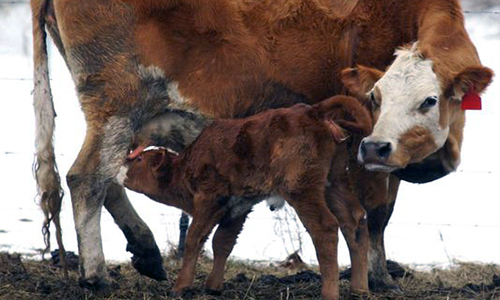Cow-calf herd owners can send more pounds of beef to market by feeding calves after weaning. It’s called backgrounding to prepare calves for the feedlot.
Speaking at the Missouri Livestock Symposium in Kirksville, December 2, Eric Bailey asked producers to think bigger.
Adding more pounds to calves makes sense in Missouri with plentiful feed and forage. Bailey, a new University of Missouri Extension beef nutritionist, gives farmers a fresh view of what they have.
Growing up on a ranch in New Mexico allows Bailey to marvel at Missouri beef cattle resources. Quality cattle plus good feed make a money-making combination. Bailey wasn’t the only one at the symposium offering the idea. Other speakers on the beef track came from states to the southwest. They urged herd owners to plan and manage more. Bailey said current markets seek bigger calves. The futures markets indicate good prices ahead.
There’s another reason to hold calves. Most weaned calves go to market in September, October, and November. A seasonal price drop happens every year. “Buyers get picky when lots of calves are available,” Bailey said. Becoming a feeder-calf producer beats that market trend. Feeding after weaning adds more pounds, which buyers want.
Later in the program, beef panelists urged herd owners to become marketers, not just sellers. A management plan can be flexible. It’s not doing the same thing at the same time each year. Owners can react to the market outlooks that can change each year.
In his talk, Bailey told tips for feeder calf operators.
First, think basic animal husbandry, he said. Weaning can be traumatic as calves go from mama’s milk and eating forage to learning to eat feed from a bunk. They must learn a lot. Don’t stack stresses at weaning time.
One low-stress transition is to not move the calves. Reverse the usual weaning method. Move cows, not calves, out of the pasture. Or move cows-calf pairs into the dry lot. Cows lead their calves to the feed bunks.
Take care of basic care first, Bailey said. Don’t try to micromanage supplements or each mineral. Leave that for later. First priority is getting water and feed intake.
Late-weaned calves on fall stockpile eat more grass and get less milk from their cow. The cows don’t mind leaving when calves are weaning themselves.
Good care can get calves on feed and eating sooner. Research shows about half the calves weaned and penned don’t learn to eat, or drink, for three days. Some don’t learn in eight days. That leads to losses.
Calves that drink from a pond take time to learn to drink from a waterer. Give the calves an open water source, he said. Or let waterers run over to show the source of water.
Forage and feed should provide nutrients for gains of 2 to 3 pounds per day. Gaining less than 2 pounds leaves dollars on the table. Too much gain adds fleshiness (fat) and waste.
In reducing stress at weaning, Bailey assumes vaccinations and castrations were done earlier. Doing all at once stacks stress.
After weaning is done and calves are calm, other technology can be added. That includes implants and other gain enhancers.
The beef talks were one of eight tracks of topics that ran all day Saturday with other tracks including horses, sheep, meat goats and stock dogs.







